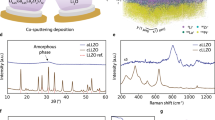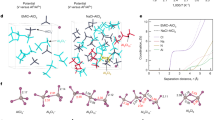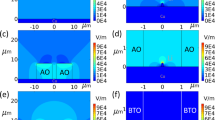Abstract
Rechargeable aprotic alkali metal (Li or Na)–O2 batteries are the subject of great interest because of their high theoretical specific energy. However, the growth of dendrites and cracks at the Li or Na anode, as well as their corrosive oxidation lead to poor cycling stability and safety issues. Understanding the mechanism and improving Li/Na-ion plating and stripping electrochemistry are therefore essential to realizing their technological potential. Here, we report how the use of a Li-Na alloy anode and an electrolyte additive realizes an aprotic bimetal Li-Na alloy–O2 battery with improved cycling stability. Electrochemical investigations show that stripping and plating of Li and Na and the robust and flexible passivation film formed in situ (by 1,3-dioxolane additive reacting with the Li-Na alloy) suppress dendrite and buffer alloy anode volume expansion and thus prevent cracking, avoiding electrolyte consumption and ensuring high electron transport efficiency and continued electrochemical reactions.
This is a preview of subscription content, access via your institution
Access options
Access Nature and 54 other Nature Portfolio journals
Get Nature+, our best-value online-access subscription
$29.99 / 30 days
cancel any time
Subscribe to this journal
Receive 12 print issues and online access
$259.00 per year
only $21.58 per issue
Buy this article
- Purchase on Springer Link
- Instant access to full article PDF
Prices may be subject to local taxes which are calculated during checkout





Similar content being viewed by others
Data availability
The authors declare that all the data supporting the findings of this study are available within the paper and its Supplementary Information.
References
Bruce, P. G., Freunberger, S. A., Hardwick, L. J. & Tarascon, J. M. Li–O2 and Li–S batteries with high energy storage. Nat. Mater. 11, 19–29 (2012).
Lu, Y., Tu, Z. & Archer, L. A. Stable lithium electrodeposition in liquid and nanoporous solid electrolytes. Nat. Mater. 13, 961–969 (2014).
Li, W. et al. The synergetic effect of lithium polysulfide and lithium nitrate to prevent lithium dendrite growth. Nat. Commun. 6, 7436–7444 (2015).
Qian, J. et al. High rate and stable cycling of lithium metal anode. Nat. Commun. 6, 6362–6371 (2015).
Wagner, F. T., Lakshmanan, B. & Mathias, M. F. Electrochemistry and the future of the automobile. J. Phys. Chem. Lett. 1, 2204–2219 (2010).
Aetukuri, N. B. et al. Solvating additives drive solution-mediated electrochemistry and enhance toroid growth in non-aqueous Li–O2 batteries. Nat. Chem. 7, 50–56 (2014).
Kundu, D., Talaie, E., Duffort, V. & Nazar, L. F. The emerging chemistry of sodium ion batteries for electrochemical energy storage. Angew. Chem. Int. Ed. 54, 3431–3448 (2015).
Zu, C. X. & Li, H. Thermodynamic analysis on energy densities of batteries. Energy Environ. Sci. 4, 2614–2624 (2011).
Tikekar, M. D., Choudhury, S., Tu, Z. & Archer, L. A. Design principles for electrolytes and interfaces for stable lithium-metal batteries. Nat. Energy 1, 16114–16121 (2016).
Choudhury, S. et al. Designer interphases for the lithium-oxygen electrochemical cell. Sci. Adv. 3, 1602809 (2017).
Wang, H., Lin, D., Liu, Y., Li, Y. & Cui, Y. Ultrahigh-current density anodes with interconnected Li metal reservoir through overlithiation of mesoporous AlF3 framework. Sci. Adv. 3, 701301 (2017).
Liang, X. et al. A facile surface chemistry route to a stabilized lithium metal anode. Nat. Energy 2, 17119–17126 (2017).
Xie., J. et al. Stitching h-BN by atomic layer deposition of LiF as a stable interface for lithium metal anode. Sci. Adv. 3, 3170–3180 (2017).
Zhao, J. et al. Air-stable and freestanding lithium alloy/graphene foil as an alternative to lithium metal anodes. Nat. Nanotech. 12, 993–999 (2017).
Tu, Z. et al. Fast ion transport at solid–solid interfaces in hybrid battery anodes. Nat. Energy 3, 310–316 (2018).
Zuo, T. T. et al. Graphitized carbon fibers as multifunctional 3D current collectors for high areal capacity Li anodes. Adv. Mater. 29, 1700389 (2017).
Yu, X. & Manthiram, A. Ambient-temperature sodium-sulfur batteries with a sodiated Nafion membrane and a carbon nanofiber-activated carbon composite electrode. Adv. Energy Mater. 5, 1500350 (2015).
Lu, X. et al. Liquid-metal electrode to enable ultra-low temperature sodium-beta alumina batteries for renewable energy storage. Nat. Commun. 5, 4578 (2014).
Ding, F. et al. Dendrite-free lithium deposition via self-healing electrostatic shield mechanism. J. Am. Chem. Soc. 135, 4450–4456 (2013).
Zhang, Y. et al. Dendrite-free lithium deposition with self-aligned nanorod structure. Nano Lett. 14, 6889–6896 (2014).
Stark, J. K., Ding, Y. & Kohl, P. A. Dendrite-free electrodeposition and reoxidation of lithium-sodium alloy for metal-anode battery. J. Electrochem. Soc. 158, A1100–A1105 (2011).
Darwiche, A. et al. Better cycling performances of bulk Sb in Na-ion batteries compared to Li-ion systems: an unexpected electrochemical mechanism. J. Am. Chem. Soc. 134, 20805–20811 (2012).
Wang, J. W., Liu, X. H., Mao, S. X. & Huang, J. Y. Microstructural evolution of tin nanoparticles during in situ sodium insertion and extraction. Nano. Lett. 12, 5897–5902 (2012).
Mizutani, Y., Kim, S. J., Ichino, R. & Okido, M. Anodizing of Mg alloys in alkaline solutions. Surf. Coat. Technol. 169, 143–146 (2003).
Tavassol, H., Cason, M. W., Nuzzo, R. G. & Gewirth, A. A. Influence of oxides on the stress evolution and reversibility during SnOx conversion and Li-Sn alloying reactions. Adv. Energy Mater. 5, 1400317 (2015).
Wei, S. et al. Stabilizing electrochemical interfaces in viscoelastic liquid electrolytes. Sci. Adv. 4, 6243–6252 (2018).
Xue, L., Gao, H., Li, Y. & Goodenough, J. B. Cathode dependence of liquid-alloy Na-K anodes. J. Am. Chem. Soc. 140, 3292–3298 (2018).
Li., Y. et al. Atomic structure of sensitive battery materials and interfaces revealed by cryo–electron microscopy. Science 358, 506–510 (2017).
Peled, E. The electrochemical behavior of alkali and alkaline earth metals in nonaqueous battery systems—the solid electrolyte interphase model. J. Electrochem. Soc. 126, 2047–2051 (1979).
Doyle, K. P., Lang, C. M., Kim, K. & Kohl, P. A. Dentrite-free electrochemical deposition of Li-Na alloys from an ionic liquid electrolyte. J. Electrochem. Soc. 153, A1353–A1357 (2006).
Scordilis-Kelley, C. & Carlin, R. T. Lithium and sodium standard reduction potentials in ambient-temperature chloroaluminate molten salts. J. Electrochem. Soc. 140, 1606–1611 (1993).
DuBeshter, T. & Jorne, J. Pulse polarization for Li-ion battery under constant state-of-charge: Part II. Modeling of individual voltage losses and SOC prediction. J. Electrochem. Soc. 164, 3395–3405 (2017).
Takami, N., Satoh, A., Hara, M. & Ohsaki, I. Structural and kinetic characterization of lithium intercalation into carbon anodes for secondary lithium batteries. J. Electrochem. Soc. 142, 371–379 (1995).
Luo, C. et al. FIB-SEM investigation on corrosion propagation of aluminium–lithium alloy in sodium chloride solution. Corrosion Eng. Sci. Technol. 50, 390–396 (2014).
Franke, P. Thermodynamic Properties of Inorganic Materials · Binary Systems. Part 5: Binary Systems Supplement 1 (Springer, Berlin, 2007).
Banerjee, R., Bose, S., Genc, A. & Ayyub, P. The microstructure and electrical transport properties of immiscible copper–niobium alloy thin films. J. Appl. Phys. 103, 033511 (2008).
Liu, C. J., Chen, J. S. & Lin, Y. K. Characterization of microstructure, interfacial reaction and diffusion of immiscible Cu(Ta) alloy thin film on SiO2 at elevated temperature. J. Electrochem. Soc. 151, 18–23 (2004).
Liu, Y. et al. Making Li-metal electrodes rechargeable by controlling the dendrite growth direction. Nat. Energy 2, 17083 (2017).
Aurbach, D. et al. Review of selected electrode–solution interactions which determine the performance of Li and Li ion batteries. J. Power Sources 89, 206–218 (2000).
Etacheri, V. et al. Exceptional electrochemical performance of Si-nanowires in 1,3-dioxolane solutions: a surface chemical investigation. Langmuir 28, 6175–6184 (2012).
Miao, R. et al. Novel dual-salts electrolyte solution for dendrite-free lithium-metal based rechargeable batteries with high cycle reversibility. J. Power Sources 271, 291–297 (2014).
Yan, C. et al. Lithium metal protection through in-situ formed solid electrolyte interphase in lithium-sulfur batteries: the role of polysulfides on lithium anode. J. Power Sources 327, 212–220 (2016).
Yadegari, H. et al. Three-dimensional nanostructured air electrode for sodium–oxygen batteries: a mechanism study toward the cyclability of the cell. Chem. Mater. 27, 3040–3047 (2015).
Liu, Q. C. et al. Artificial protection film on lithium metal anode toward long-cycle-life lithium–oxygen batteries. Adv. Mater. 27, 5241–5247 (2015).
Elia, G. A. et al. An advanced lithium–air battery exploiting an ionic liquid-based electrolyte. Nano Lett. 14, 6572–6577 (2014).
Liu, W. M. et al. NiCo2O4 nanosheets supported on Ni foam for rechargeable nonaqueous sodium–air batteries. Electrochem. Commun. 45, 87–90 (2014).
Acknowledgements
This work was financially supported by the National Key R&D Program of China (grants 2017YFA0206700), the National Natural Science Foundation of China (grants 21725103, 51472232, 51522101, 51471075, 51631004, 21771013 and 51522202), the Strategic Priority Research Program of the Chinese Academy of Sciences (grant XDA09010404), JCKY2016130B010, 111 project (grant B14009), and the Program for the JLU Science and Technology Innovative Research Team (2017TD-09).
Author information
Authors and Affiliations
Contributions
X.B.Z., J.M.Y., Y.Z. and J.L.M. developed the research concept. J.M.Y. designed the Li-Na alloy and catalyst, and J.L.M. then prepared the materials. X.B.Z. designed the electrochemical experiments, which J.L.M and Y.Y. performed. X.B.Z., J.M.Y., Y.Z., J.L.M. and F.L.M. contributed to interpretation of the results and wrote the manuscript, and all authors contributed to the scientific discussion.
Corresponding authors
Ethics declarations
Competing interests
The authors declare no competing interests.
Additional information
Publisher’s note: Springer Nature remains neutral with regard to jurisdictional claims in published maps and institutional affiliations.
Supplementary information
Supplementary Information
Supplementary Methods, Supplementary Figures 1–27, Supplementary Tables 1–4
Rights and permissions
About this article
Cite this article
Ma, Jl., Meng, Fl., Yu, Y. et al. Prevention of dendrite growth and volume expansion to give high-performance aprotic bimetallic Li-Na alloy–O2 batteries. Nature Chem 11, 64–70 (2019). https://doi.org/10.1038/s41557-018-0166-9
Received:
Accepted:
Published:
Issue Date:
DOI: https://doi.org/10.1038/s41557-018-0166-9
This article is cited by
-
Polarizable Additive with Intermediate Chelation Strength for Stable Aqueous Zinc-Ion Batteries
Nano-Micro Letters (2024)
-
Fast Ion Conductor Nanofibers and Aramid Nanofibers with Hydrogen Bonds Synergistically Enhanced Composite Solid Electrolytes
Advanced Fiber Materials (2024)
-
High-Energy Room-Temperature Sodium–Sulfur and Sodium–Selenium Batteries for Sustainable Energy Storage
Electrochemical Energy Reviews (2023)
-
A fiber-reinforced solid polymer electrolyte by in situ polymerization for stable lithium metal batteries
Nano Research (2023)
-
Free-standing Na2C6O6/MXene composite paper for high-performance organic sodium-ion batteries
Nano Research (2023)



